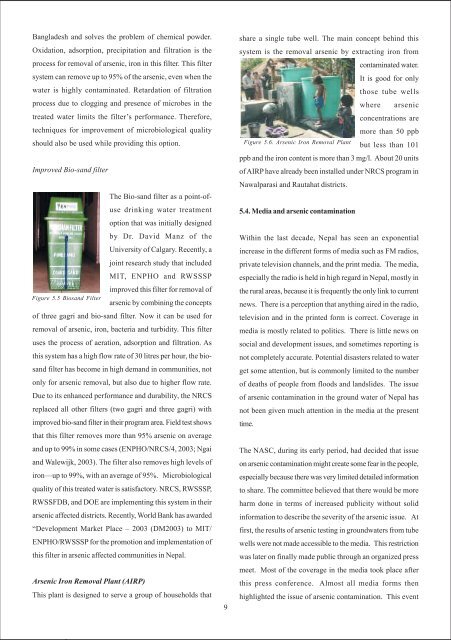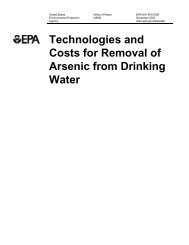The State of Arsenic in Nepal - 2003 - Harvard University ...
The State of Arsenic in Nepal - 2003 - Harvard University ...
The State of Arsenic in Nepal - 2003 - Harvard University ...
Create successful ePaper yourself
Turn your PDF publications into a flip-book with our unique Google optimized e-Paper software.
Bangladesh and solves the problem <strong>of</strong> chemical powder.<br />
Oxidation, adsorption, precipitation and filtration is the<br />
process for removal <strong>of</strong> arsenic, iron <strong>in</strong> this filter. This filter<br />
system can remove up to 95% <strong>of</strong> the arsenic, even when the<br />
water is highly contam<strong>in</strong>ated. Retardation <strong>of</strong> filtration<br />
process due to clogg<strong>in</strong>g and presence <strong>of</strong> microbes <strong>in</strong> the<br />
treated water limits the filter’s performance. <strong>The</strong>refore,<br />
techniques for improvement <strong>of</strong> microbiological quality<br />
should also be used while provid<strong>in</strong>g this option.<br />
Improved Bio-sand filter<br />
<strong>The</strong> Bio-sand filter as a po<strong>in</strong>t-<strong>of</strong>use<br />
dr<strong>in</strong>k<strong>in</strong>g water treatment<br />
option that was <strong>in</strong>itially designed<br />
by Dr. David Manz <strong>of</strong> the<br />
<strong>University</strong> <strong>of</strong> Calgary. Recently, a<br />
jo<strong>in</strong>t research study that <strong>in</strong>cluded<br />
MIT, ENPHO and RWSSSP<br />
improved this filter for removal <strong>of</strong><br />
Figure 5.5 Biosand Filter<br />
arsenic by comb<strong>in</strong><strong>in</strong>g the concepts<br />
<strong>of</strong> three gagri and bio-sand filter. Now it can be used for<br />
removal <strong>of</strong> arsenic, iron, bacteria and turbidity. This filter<br />
uses the process <strong>of</strong> aeration, adsorption and filtration. As<br />
this system has a high flow rate <strong>of</strong> 30 litres per hour, the biosand<br />
filter has become <strong>in</strong> high demand <strong>in</strong> communities, not<br />
only for arsenic removal, but also due to higher flow rate.<br />
Due to its enhanced performance and durability, the NRCS<br />
replaced all other filters (two gagri and three gagri) with<br />
improved bio-sand filter <strong>in</strong> their program area. Field test shows<br />
that this filter removes more than 95% arsenic on average<br />
and up to 99% <strong>in</strong> some cases (ENPHO/NRCS/4, <strong>2003</strong>; Ngai<br />
and Walewijk, <strong>2003</strong>). <strong>The</strong> filter also removes high levels <strong>of</strong><br />
iron—up to 99%, with an average <strong>of</strong> 95%. Microbiological<br />
quality <strong>of</strong> this treated water is satisfactory. NRCS, RWSSSP,<br />
RWSSFDB, and DOE are implement<strong>in</strong>g this system <strong>in</strong> their<br />
arsenic affected districts. Recently, World Bank has awarded<br />
“Development Market Place – <strong>2003</strong> (DM<strong>2003</strong>) to MIT/<br />
ENPHO/RWSSSP for the promotion and implementation <strong>of</strong><br />
this filter <strong>in</strong> arsenic affected communities <strong>in</strong> <strong>Nepal</strong>.<br />
<strong>Arsenic</strong> Iron Removal Plant (AIRP)<br />
This plant is designed to serve a group <strong>of</strong> households that<br />
9<br />
share a s<strong>in</strong>gle tube well. <strong>The</strong> ma<strong>in</strong> concept beh<strong>in</strong>d this<br />
system is the removal arsenic by extract<strong>in</strong>g iron from<br />
contam<strong>in</strong>ated water.<br />
It is good for only<br />
those tube wells<br />
where arsenic<br />
concentrations are<br />
more than 50 ppb<br />
Figure 5.6. <strong>Arsenic</strong> Iron Removal Plant<br />
but less than 101<br />
ppb and the iron content is more than 3 mg/l. About 20 units<br />
<strong>of</strong> AIRP have already been <strong>in</strong>stalled under NRCS program <strong>in</strong><br />
Nawalparasi and Rautahat districts.<br />
5.4. Media and arsenic contam<strong>in</strong>ation<br />
With<strong>in</strong> the last decade, <strong>Nepal</strong> has seen an exponential<br />
<strong>in</strong>crease <strong>in</strong> the different forms <strong>of</strong> media such as FM radios,<br />
private television channels, and the pr<strong>in</strong>t media. <strong>The</strong> media,<br />
especially the radio is held <strong>in</strong> high regard <strong>in</strong> <strong>Nepal</strong>, mostly <strong>in</strong><br />
the rural areas, because it is frequently the only l<strong>in</strong>k to current<br />
news. <strong>The</strong>re is a perception that anyth<strong>in</strong>g aired <strong>in</strong> the radio,<br />
television and <strong>in</strong> the pr<strong>in</strong>ted form is correct. Coverage <strong>in</strong><br />
media is mostly related to politics. <strong>The</strong>re is little news on<br />
social and development issues, and sometimes report<strong>in</strong>g is<br />
not completely accurate. Potential disasters related to water<br />
get some attention, but is commonly limited to the number<br />
<strong>of</strong> deaths <strong>of</strong> people from floods and landslides. <strong>The</strong> issue<br />
<strong>of</strong> arsenic contam<strong>in</strong>ation <strong>in</strong> the ground water <strong>of</strong> <strong>Nepal</strong> has<br />
not been given much attention <strong>in</strong> the media at the present<br />
time.<br />
<strong>The</strong> NASC, dur<strong>in</strong>g its early period, had decided that issue<br />
on arsenic contam<strong>in</strong>ation might create some fear <strong>in</strong> the people,<br />
especially because there was very limited detailed <strong>in</strong>formation<br />
to share. <strong>The</strong> committee believed that there would be more<br />
harm done <strong>in</strong> terms <strong>of</strong> <strong>in</strong>creased publicity without solid<br />
<strong>in</strong>formation to describe the severity <strong>of</strong> the arsenic issue. At<br />
first, the results <strong>of</strong> arsenic test<strong>in</strong>g <strong>in</strong> groundwaters from tube<br />
wells were not made accessible to the media. This restriction<br />
was later on f<strong>in</strong>ally made public through an organized press<br />
meet. Most <strong>of</strong> the coverage <strong>in</strong> the media took place after<br />
this press conference. Almost all media forms then<br />
highlighted the issue <strong>of</strong> arsenic contam<strong>in</strong>ation. This event

















